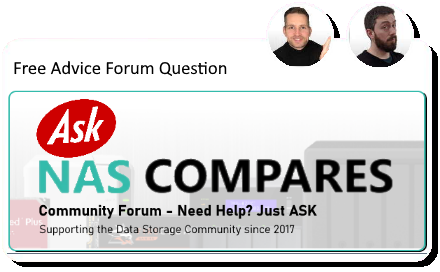Posts: 1,071
Threads: 1,072
Joined: Feb 2020
Reputation:
2
Good evening,
I love watching your videos, and I bought a ds920+ based off your recommendations and videos on them. It has been fantastic for a few years, now I am looking to upgrade and build a much larger storage device. However I also want to build a gaming pc, so my hope is to build an all in one.
This is a link to a build I made on Newegg I just don't know if there would be any issues with it.
https://newegg.io/ce23daa8
I've seen some of your videos saying how certain CPUs are better for servers. To make this I basically googled best gaming components added those, searched best tower pc cases for nas build, and looked up cards needed for 10gbe and sata cards.
Any input would best fantastic.
Posts: 5,379
Threads: 2
Joined: Jun 2022
Reputation:
35
Thanks for reaching out, and I’m really glad the DS920+ worked out well for you. It’s a solid little system, but your new goals sound like a serious leap in both performance and storage — combining a high-capacity NAS with a gaming PC is definitely doable, though there are a few key things to keep in mind to avoid future headaches.
Looking over your Newegg build link, here’s what stands out and what you might want to reconsider:
1. CPU Choice – Gaming vs NAS/Server
Gaming CPUs (like Intel i9 or Ryzen 9) offer excellent single-core performance, but lack server-grade features like ECC memory support and higher PCIe lane availability. If you’re planning to run 12–16+ drives, NVMe cache, 10GbE networking, and maybe a GPU for transcoding or VMs, then workstation-class CPUs like AMD Ryzen Pro, Intel Xeon W, or even Ryzen 7000 series with ECC-compatible motherboards will offer much more stability and scalability long-term.
2. Motherboard and PCIe Lane Budget
Double-check the motherboard’s PCIe slot configuration. Many consumer boards only offer one or two full-speed x16 or x8 slots, which can bottleneck if you’re trying to install a GPU, a 10GbE NIC, and a SATA/SAS HBA card. For example, if you’re using a full-size GPU and a 16-port HBA like an LSI 9300-16i, you’ll need a board with sufficient PCIe bifurcation and bandwidth.
3. Storage Backplane and SATA Expansion
You’ll likely need an HBA (host bus adapter) card like the LSI 9300-8i or 9305-16i for 12+ drives. Avoid RAID cards unless you’re using hardware RAID — HBA in IT mode gives you flexibility for ZFS, UnRAID, or software RAID setups.
4. Case Choice
Cases marketed as “NAS-friendly” should support hot-swappable bays or allow neat cabling to backplanes. Popular ones include Fractal Define 7 XL, SilverStone CS381, or the Jonsbo N100 series. Check how many 3.5” drives can fit natively without weird brackets or limited airflow.
5. Power Supply (PSU)
With 280TB+ planned, make sure to use a platinum-rated PSU, ideally 850W or more, with enough SATA/Molex lines. Avoid using splitters if possible to reduce risk.
6. OS Consideration
You’ll need to decide upfront: are you building this as a NAS-first machine (TrueNAS, UnRAID, Proxmox with NAS VM), or as a Windows gaming machine that runs file sharing and Plex in the background? That will influence your partitioning and storage pool layout.
7. Noise & Thermals
Combining a high-performance GPU with lots of spinning drives can generate both heat and noise. Look into fan curves and isolation mounts if you’re planning to have this in a semi-quiet space.
8. Networking
A 10GbE NIC is a great choice — go with Intel X550-T2 or a Mellanox ConnectX-4 if your OS supports it. Just make sure your switch and cabling are ready for the throughput.





